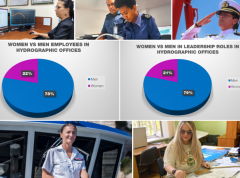Analysis of the Status of Surveys
Analysis of the Status of Surveys
The categorisation in the reports is underpinned by detailed national assessment using S-44 criteria, the zones of confidence (CATZOC) defined in S-57, or some other systematic classification of source data.
The entire extent of navigable waters in each national area, out to the limits of the EEZ, has been assessed. Whereas the First Edition of this publication published a simple percentage of the entire EEZ, the Second Edition adopted 3 bands (< 50m, < 200m and > 200m). This was too complex for most countries to handle. For this edition, analysis was requested within and outside the 200m contour.
There are some areas of significant progress since the publication of the second edition of C-55. In a number of regions a systematic approach has been taken to the identification and prioritisation of hydrographic effort e.g. the Helsinki Communiqué (HELCOM) fairway agreement in the Baltic Sea. Members of the organization for the protection of the environment of the Red Sea and Gulf of Aden (PERSGA) have provided another example of concerted action to address a major regional deficiency, and a new Traffic Separation Scheme (TSS) and other recommended routeing measures are now in place in the N approaches to the Strait of Bab el Mandeb. Planning is in hand, through the Marine Electronic Highway project to address shortcomings in the Strait of Malacca and S China Sea. The highway concept is also being applied in the development of projects in other areas.
Major deficiencies:
Of the area deficiencies identified in the first edition, the following remain extant:
- On the W coast of Africa:
- Some coastal waters of Western Sahara and Mauritania.
- Coastal waters off the Niger River delta.
- Coastal waters off Cabinda.
- The River Congo up to Matadi.
- On the E coast of Africa:
- The deeper waters of the Red Sea between the S approaches to the Gulf of Suez and the N
- approaches to the Strait of Bab el Mandeb.
- Coastal waters of Sudan from Port Sudan southwards.
- The inland lakes of Africa.
- Areas of the S China Sea and Java Sea.
- The Gulf of Papua.
- Mariners continue to report concern over the large areas of unsurveyed waters which are delineated on charts of the Persian Gulf.
The IMO has high-lighted concerns reported from the following areas:
- The S side of the Sicilian channel.
- The Mozambique Channel.
- The straits and the partial system of archipelagic sea lanes in Indonesian archipelagic waters.
- The channels around Cuba and the Dominican Republic.
The advent of deeper draught shipping has increased the urgency of national programmes to review and upgrade coverage which predates the deployment of sidescan sonar and multi-beam echo sounder (MBES). The increasing tendency of cruise liners to seek new routes, anchorages, and port calls, has high-lighted the need for more rigorous survey of areas which were originally explored in the nineteenth century. This is a major challenge for developing hydrographic services in the Caribbean, Indian Ocean and W Pacific areas. It also requires the continued commitment of those states which invest in survey programmes in the polar regions. New techniques such as LIDAR may assist progress in some sea areas, but they are expensive to deploy. Regional project co-ordination and cost-sharing should be fully exploited.
Many countries, both with long-established and with developing hydrographic capabilities, are responsible for safe access to ports in areas where the seabed is unstable. Routine re-survey programmes are essential in such areas. There is a real need for those states with expertise in managing such programmes to share their experience.
Renewed attention needs to be given to the disproving of vigias and to the positioning of remote islands, especially adjacent to the maritime shipping routes in the Pacific and adjacent seas.
To date, the IHO has not taken cognisance of hydrography on rivers and inland waterways. However, there is clear evidence within the RHCs of need for guidance and sharing of information. To this end, states with significant inland waterways have been included in this edition.




Share this page: